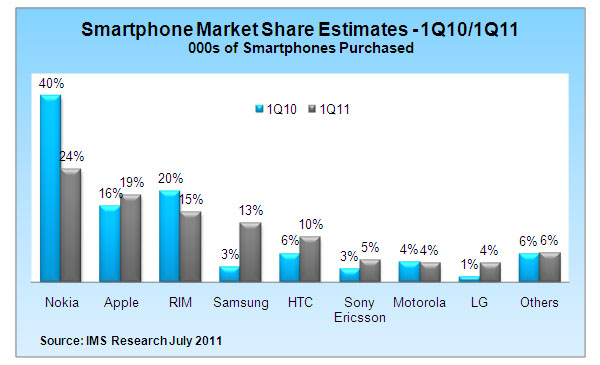
Market analysis firm IMS Research as released new figure that forecast that some 420 million mobile handsets will be sold during 2011—and 28 percent of those (nearly 118 million) will be smartphones. And the mobile device revolution shows no signs of slowing down: according to the report, worldwide mobile handset sales will pass one billion devices by the end of 2016…and about half those devices will be smartphones.
“One of the key dynamics of the mobile handset competitive environment in recent years has been the inability of many traditional market leaders to recognize and adjust to the growing smartphone tier,” said IMS Research analyst Josh Builta, in a statement. “These lapses have created opportunities for newer entrants to the market, which they have aggressively pursued.”
No surprise, the new players in the smartphone market include Apple (which IMS forecasts will walk away with 19 percent of the global market this year), along with Samsung and HTC which have both seen their share of the smartphone market explode between 2010 and 2011, with Sony Ericsson also seeing some benefit. The big losers are also no surprise: Finland’s Nokia (which is in the midst of dropping Symbian and converting over to Windows Phone), and Canada’s Research in Motion. IMS Research also calls out LG, which despite being the third-largest handset maker on the planet, is expected to account for less than four percent of the smartphone market this year.
IMS Research doesn’t call out a single reason why major handset makers have stumbled in transitioning to smartphones, but notes that poorly designed products and interfaces are a factor, along with failing to come up with a product that’s sufficiently differentiated from the rest of the market.
The longer the former handset giants hold off on getting competitive in the smartphone space, IMS Research warns, the tougher it will be to get a foothold in the market.
“Though the other OEMs are stepping up their efforts in the space, companies such as Apple, HTC, and Samsung have a considerable amount of momentum. Catching them will not be an easy task,” said Builta.


